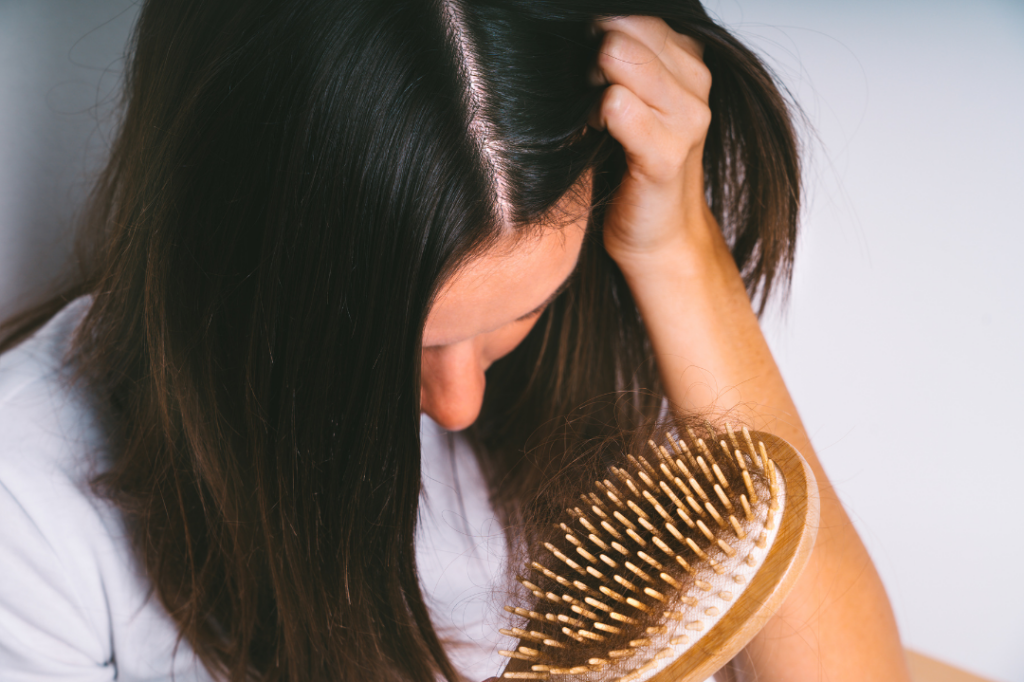Postpartum hair loss, medically known as postpartum alopecia, is a common phenomenon experienced by many new mothers. The shedding of hair after giving birth can be alarming, but it’s typically a temporary condition. In recent years, interest has surged in the potential role of saw palmetto and other ingredients in dermatology to manage postpartum hair loss. In this blog, we’ll delve into the most frequently asked questions surrounding postpartum hair loss, explore the mechanisms of action behind saw palmetto and other ingredients, discuss therapeutic interventions, and examine the pivotal role compounding pharmacies play in tailoring treatments for individual needs.
Understanding Postpartum Hair Loss:
- What causes postpartum hair loss? Postpartum hair loss is primarily attributed to hormonal fluctuations. During pregnancy, elevated levels of estrogen prolong the hair’s growth phase, resulting in thicker and fuller hair. However, after childbirth, estrogen levels drop significantly, causing the hair to enter the resting phase and ultimately shed. This shedding typically peaks around three to six months postpartum but gradually resolves over time.
- Is postpartum hair loss normal? Yes, postpartum hair loss is a normal physiological response and affects approximately 40-50% of women. While it can be distressing to witness excessive hair shedding, especially for those experiencing it for the first time, rest assured that it’s a temporary condition and hair growth usually resumes within six to twelve months postpartum.
- How long does postpartum hair loss last? The duration of postpartum hair loss varies from one individual to another. For most women, the shedding peaks around three to six months postpartum and gradually diminishes over the subsequent months. Hair growth typically returns to pre-pregnancy levels within six to twelve months after childbirth.
Exploring Saw Palmetto and Other Ingredients:
- What is saw palmetto? Saw palmetto (Serenoa repens) is a palm-like plant native to the southeastern United States. It has a long history of traditional use in herbal medicine, particularly for its purported benefits in managing benign prostatic hyperplasia (BPH) and promoting hair growth. Saw palmetto extract is rich in fatty acids and phytosterols, which are believed to possess anti-androgenic properties.
- How does saw palmetto work for postpartum hair loss? The mechanism of action of saw palmetto in addressing postpartum hair loss revolves around its ability to inhibit the enzyme 5-alpha-reductase. This enzyme converts testosterone into dihydrotestosterone (DHT), a potent androgen implicated in hair miniaturization and follicular shrinkage. By reducing DHT levels, saw palmetto may help mitigate the effects of hormonal imbalances on hair follicles, thereby promoting hair growth.
- What other ingredients are beneficial for postpartum hair loss? In addition to saw palmetto, several other ingredients have garnered attention for their potential role in managing postpartum hair loss. These include biotin, a B-vitamin essential for healthy hair growth; zinc, which supports immune function and aids in tissue repair; and keratin, a protein that strengthens hair shafts and improves resilience.
Therapeutic Interventions for Postpartum Hair Loss:
- Are there any effective treatments? While postpartum hair loss typically resolves on its own, certain therapeutic interventions may help expedite the regrowth process and improve hair health. Topical minoxidil, a vasodilator that enhances blood flow to the scalp, is commonly recommended for stimulating hair growth in both men and women. Additionally, incorporating dietary supplements containing saw palmetto, biotin, zinc, and keratin may complement topical treatments and support overall hair health.
- Can dietary modifications aid in managing postpartum hair loss? While no specific diet can prevent postpartum hair loss, consuming a nutrient-rich diet abundant in fruits, vegetables, lean proteins, and healthy fats can promote optimal hair growth and minimize deficiencies that may exacerbate hair shedding. Incorporating foods rich in vitamins A, C, D, and E, as well as omega-3 fatty acids, can nourish the scalp and support hair follicle function.
The Role of Compounding Pharmacies:
- What is a compounding pharmacy? Compounding pharmacies specialize in preparing customized medications tailored to meet individual patients’ unique needs. They play a vital role in dermatology by formulating personalized topical solutions, oral supplements, and other dosage forms to address specific skin and hair concerns.
- How do compounding pharmacies contribute to postpartum hair loss management? Compounding pharmacies offer a personalized approach to postpartum hair loss management by formulating custom blends of active ingredients, including saw palmetto, biotin, zinc, and keratin, based on individual patient assessments and preferences. These tailored formulations ensure precise dosing and delivery mechanisms, optimizing therapeutic outcomes while minimizing potential side effects.
Conclusion:
Postpartum hair loss can be a distressing experience for many new mothers, but it’s essential to recognize that it’s a temporary condition with a high likelihood of spontaneous resolution. While saw palmetto and other ingredients hold promise in managing postpartum hair loss by addressing hormonal imbalances and supporting hair health, it’s crucial to consult with healthcare professionals before initiating any treatment regimen. By combining evidence-based interventions, such as topical minoxidil and dietary supplements, with the personalized formulations offered by compounding pharmacies, women can navigate postpartum hair loss with confidence and reclaim healthy, vibrant hair.
For more information or to order your medical compound, simply upload your prescription and we will get in touch with you.
Follow us on Instagram for our latest skincare content!

Lane Khin, the compounding pharmacist of My Skin Pharmacy, brings a wealth of knowledge from the worlds of pharmacy and dermatology to the table. With degrees in Pharmacy and Applied Science from QUT, Lane combines a deep understanding of compounding and skincare with a friendly, accessible approach. Through My Skin Magazine, Lane shares her expertise, offering readers practical advice and insights into personalised skincare solutions. Lane has a real passion for helping others achieve their best skin.

